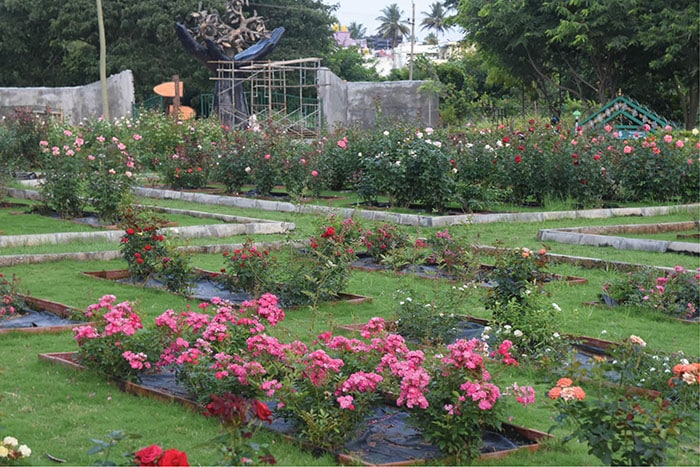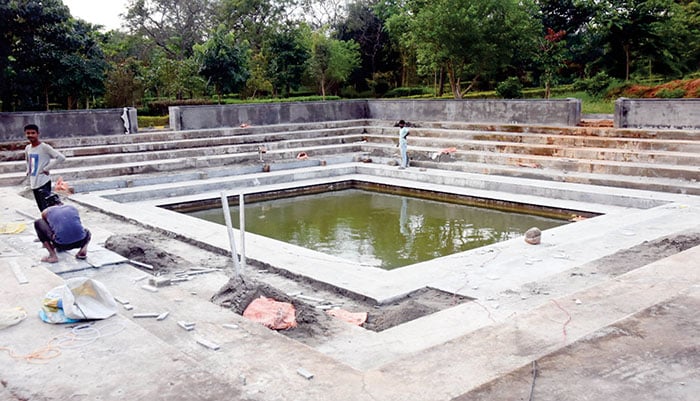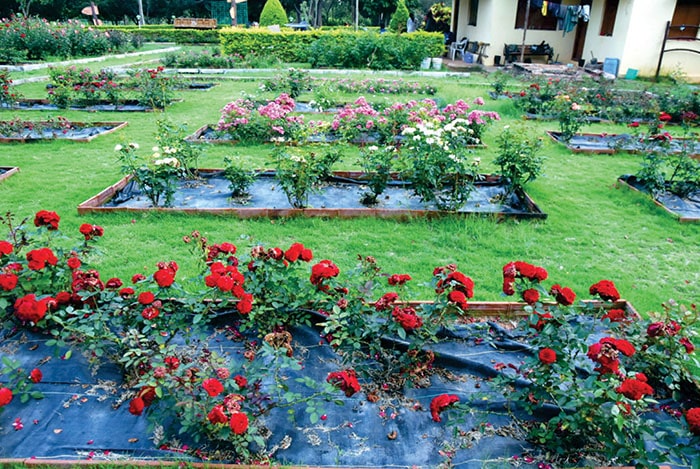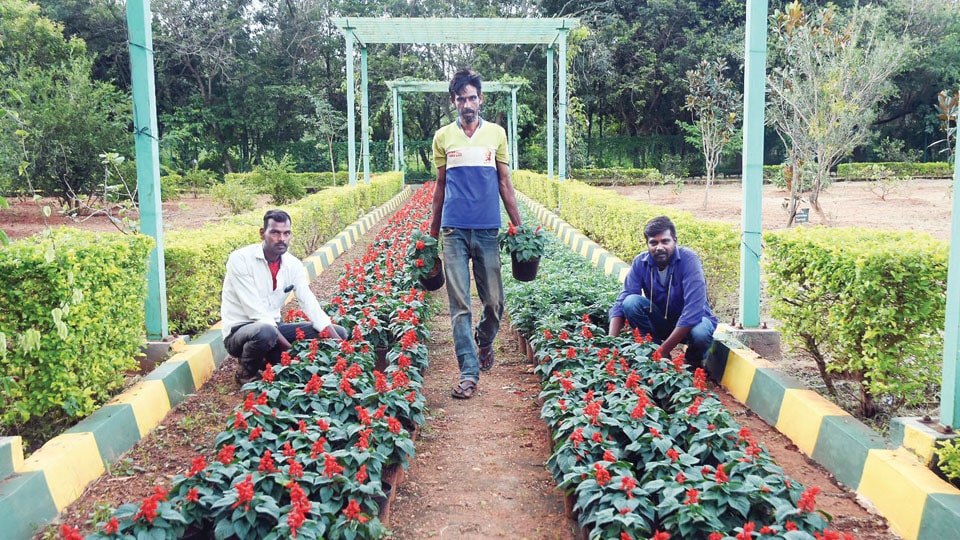City’s first Botanical Garden has over 300 species of exotic and rare plants
By M.T. Yogesh Kumar
Mysore/Mysuru: Eleven years after it was first proposed, Mysuru city’s first Botanical Garden will open for visitors and tourists on Sept. 26, coinciding with the inauguration of Dasara-2022. The Garden will be open from 7 am to 7 pm.
The idea of the Lingambudhi Botanical Garden was floated in 2011 along the lines of the Lalbagh Botanical Garden and the famed Botanical Garden at Ooty and the wait is finally over.
“The Botanical Garden has been developed on a 15-acre plot with an estimated budget of Rs. 4 crore. The garden will be inaugurated on Sept. 26 symbolically during the inauguration of the Dasara Flower Show at Kuppanna Park. On Sept. 27, Horticulture Minister N. Munirathna will visit the Botanical Garden,” Horticulture Department Deputy Director Rudresh told Star of Mysore.
Lingambudhi Lake in Srirampura II Stage, Ramakrishnanagar, attracts birds from far and wide. It has over 300 varieties of plants and medicinal plants too. The Botanical Garden has been developed in such a way that it will emerge as a natural study centre for Botanists, Zoology students and others who have keen interest in natural resources.
To start with, the Garden area was cleared of bushes and beautified. Over 300 different plant species made an entry and the Garden now is dedicated to the collection, acclimatisation, conservation, multiplication and display of a wide range of indigenous and exotic plant species.
The Botanical Garden has been laid out with themes including medicinal and aromatic garden, rose garden, topiary garden, butterfly garden, bamboo block, ficus block, rockery, arboretum, fragrance block, palmatum, minor fruits block and well-maintained water pools to attract aqua birds.

Indigenous tree species
Over 26 indigenous tree species have been grown here like the large-flowered bay tree, Krishna siris, black varnish tree, Karen wood, marking nut tree, hiptage, weeping bottle brush, red bottle brush, orange climber, stone apple and many more. Also, one can see here that a lot of space has been provided for the conservation of endangered tree species like albizia, Indian bael, red sanders and other endangered species.
There are over 30 varieties of medicinal and aromatic plant species planted on one-acre land. Plants with different textured leaves and medicinal and aromatic significance can be found here. Plants include soap berries, true cinnamon tree, cluster fig, Arjuna tree, myrobalan tree, golden shower, Tamanu, jungle cork tree, neem, loquat, peacock chaste tree, kokum and many others.

Bamboo block, ficus block
Lingambudhi Botanical Garden has a separate bamboo block consisting of 17 different species of bamboo. They are distinctive in their own way. Some of the species raised here are Buddha bamboo, umbrella bamboo, guadua bamboo, Japanese arrow bamboo, hedge bamboo, green glaucous bamboo and black bamboo.
The ficus block with trees having wide canopies acts as a huge lung space for the Lake and more than 18 species of ficus trees are grown here including showy silk cotton tree, African locust bean, tree of sadness, solitary fishtail palm, Krishna fig, wood apple, burflower tree, Ashwatha tree, jack fruit tree, umbrella tree, Jamun tree and Mysore fig.
The trees surrounding the small ponds by the side of the Lake act as dovecot for migratory birds for breeding. Over 5-6 very rare varieties of lotus are grown here. The Pergola inside the Garden provides partial shelter and shade for the pathway. Beautiful red jade vines spread across the pergola and the vine blooms twice a year.

Rose garden, topiary
The rose garden has 80 varieties of roses that display different colours and shapes. The beauty is enhanced by miniature roses, standard roses and hybrid roses.
Topiary is the art of clipping and shearing the foliage shrubs and small trees into ornamental or abstract shapes and this art has been put to use well at the Lingambudhi Botanical Garden. Plants with dark green foliage are selected, trained and shaped to attain the desired shapes of birds, animals and other abstract shapes. Foliage like Isaan Patri, duranta, duranta hedge, duranta gold, thuja and eugenia are grown to carve different shapes.
As part of the Botanical Garden, the Department of Horticulture has developed a butterfly garden too. Over 34 varieties of flowering plants that butterflies love to feed on and lay eggs have been planted including Mexican butterfly weed, Chinese violet, porcupine flower, yellow bell orchid tree, Asia butterfly bush, Madagascar butterfly bush, peacock flower, crown flower and candle bush.

About Lingambudhi Lake
Lingambudhi Lake Park is located on the northern and eastern sides of Lingambudhi Lake. It is a biodiversity park with its rich green foliage providing a green cover for different species of birds and insects.
According to history, this Lake was built by Mummadi Krishnaraja Wadiyar in 1828 in memory of Maharani Krishna Vilasa Lingajammanni. It has a 250-acre area, which includes 51.3 acres coming under Lingambudhi Survey No. 23, 136.11 acres coming under Dattagalli Survey No. 82 and 28.23 acres coming under Ayyajjayyanahundi Survey No.11. While 150-acre area of the Lake is covered by water, the remaining 100-acre has been declared as Reserve Forest area.
BOTANICAL GARDENS IN KARNATAKA
- Lalbagh Botanical Garden was built by Mark Cubbon in 1856
- Father of Horticulture Dr. M.H. Marigowda Botanical Garden at Doddasagere village in Tumakuru
- Lingambudhi Lake Botanical Garden, Mysuru
- Annakunuru Botanical Garden in Chikkaballapura (work in progress)
- Tarakanahalli Botanical Garden in Uttara Kannada (work in progress)
- Kannamangala Botanical Garden in Bengaluru East (work in progress)








We have so many lakes in Bangalore itself but they are so under maintained. Toxic waste is dumped into them hence creating a thick layer over it hence making it harmful for fishes and birds trying to create an ecosystem around it. Can’t walk around such lakes. Even the greenary is under maintained. Such lakes could be used as a great source of drinking water but it’s at its own mercy.